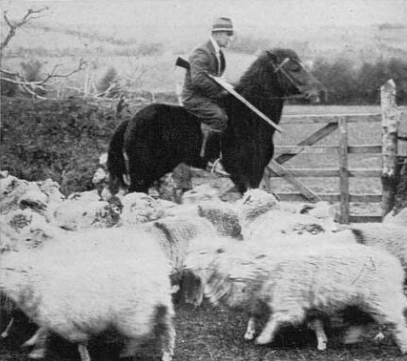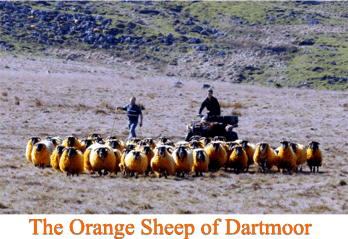
Mention the word rustlers and thrilling images of masked cowboys running off herds of cattle with a posse of armed men chasing after them. Today, sadly that is not the case, probably imagine a group of men, sneaking around in the dead of night on a well planned mission to steal a farmers profits for their own gain. In all reality the chances of ever getting caught in the are pretty slim as the majority of these crimes take place at remote and secluded locations of the moor.
It was reported that sometime between the 24th of July and the 4th of August 2016 thirty lambs and eight ewes were stolen from Gidleigh Common. In other words rustlers had been at work and the very fact that livestock graze the open commons of Dartmoor make them easy targets. Having said that it would never be a case of simply going to a remote spot and taking sheep or cattle. Firstly you would need some idea of where the animals could be found which is relatively easy as both cattle and sheep tend to congregate in the same areas known as lairs. This was just be a matter of visiting the moor and observing the livestock movements. Secondly you would need a method of rounding the animals up such as dogs or quad bikes and thirdly you would need something to take them away in such as a trailer or livestock transporter. Clearly one would need a dubious source that would be willing to slaughter and butcher the animals before disposing of them into a black market. But why would anyone go to so much bother? Simple, the average deadweight price in Southern England for the end of August 2016 for medium lambs it was £4.19 per kilo. Therefore at those prices thirty lambs with an average weight of 20kg assuming they were Scotch Blackfaces would fetch £2,514p in the normal market, allow say £500 reduction for the illegal market and you are left with around £2,000 – not bad for a night’s work? In 2016 the National Farmers Union reported that in 2015 “Livestock rustling remains a huge problem with costs stubbornly high in Northern Ireland, the North East and South West of England. At a total cost to the UK of £2.9 million, 70% came from these three regions.”
It’s worth bearing in mind that this is but one case of livestock theft of Dartmoor, there have been numerous other examples in recent years. It does not take a mathematician to work out the annual losses to local farming economy such thefts amount to. For a farmer it is not only the financial loss, in many if the stolen animals are replaced it will mean getting to know where their lairs will be. As noted above moorland livestock naturally select preferred areas for grazing etc known as ‘lairs’. Once these have been established it most cases it’s easy for the farmer to find them but every time new replacements are brought it then a lot of time can be spent working out where these animals congregate. This in itself poses a problem because once the rustlers get to know where the lairs are they know only to well that there will be a flock of sheep in the vicinity. In 1950 some Dartmoor sheep farmers were reported to have taken to patrolling the moor in an attempt to safeguard their flocks which caused some concern. However:
“Mr. G. W. Hodge, of Klondyke, Okehampton who farms on the edge of the Moor, discounted reports of armed patrols on his side of the Moor. ‘We are just looking after our own sheep in the normal way. Admittedly fog and snow reduced visibility to about 20 yards this morning, but when I went out on the Moor to see my cattle I did not meet a soul.’ Mr T. R. Thomas, group secretary of the Farmer’s Union, said he knew there had been general complaint of persistent losses of sheep bigger than one would expect from the normal hazards of weather and mires, but he had no knowledge at all of any organised armed patrols.” – The Western Morning News, December 15th, 1950. However, whether or not on this occasion the accusations were false, farmers armed with shotguns had been known to patrol Dartmoor –

The above photograph taken in 1933 clearly shows a man on his pony carrying a shotgun who appears to be checking his flock of sheep. So it would indicate that the above concerns raised in 1950 were not without historical cause. The text along with the image read; “A Dartmoor Menace: Farmers are mounting guard over their flocks in certain districts of Dartmoor where there has been an alarming increase in sheep stealing. One farm lost as many as thirty sheep in a night.” – The Sphere, April 8th, 1950.
Livestock theft or rustling on Dartmoor is by no means a modern-day phenomenon as it has been occurring for centuries, with regards to ‘sheep stealers’ there is no doubt that this was a serious problem on and around Dartmoor. In 1808 Vancouver, 1969, p.367 clearly states:
“Sheep stealing is carried on to a most atrocious extent, particularly in the vicinity of the forests of Exmoor and Dartmoor. A well attested fact states that one farmer lost in the course of five years no less than 108 sheep from off the former of these wastes; and it is no uncommon case for farmers in the neighbourhood of these moors to lose 20 sheep in the course of a season .”
Look at any old newspaper and you will see numerous Assize reports of such crimes. For instance on the 26th of February 1864 The Western Times reported that: “James Langmead, 44, a well known yeoman who has occupied several positions of trust as a public officer and been steward to the Earl of Fortescue, was placed at the bar under three indictments, for stealing 21 sheep at Belstone on the 22nd Dec..” Another case was reported in the Exeter Flying post on the 29th of March 1827: “John Knight, was indicted for stealing, on the night of Sept. 4th last, from a field in Ashburton, two sheep and one lamb,” in his defence Knight pleaded that: “No life can be worse than mine has been – I have had nothing to eat but apples and blackberries for four days.” Nevertheless he was found guilty and sentenced to transportation for life, the fixed penalty for such an offence. In The Western Times on the 28th of January 1854 another report from Ashburton read: “Ashburton – Sheep Stealing – The crime of sheep stealing still continues in this district. On Friday night last, a fine fat sheep was killed and carried off from Gulwell Farm, the property of Messrs Perry.” Similarly in the Western Times on the 12th of July 1851: “Sixty-Two sheep were seized on Heathercombe Farm, in the parish of Manaton, on Wednesday last, the property of John French, who was transported for seven years at the recent sessions for sheep stealing.” These are but a minuscule amount of reports that can be found in the old newspapers but admirably go to show the severity of the problem. It’s also worth noting that such incidents also regularly occurred to cattle, horses, ponies and even poultry.
These examples show two things, not all livestock thefts were down to pure profit, in some cases it was because of a dire need to provide food for a person or their family. Secondly the punishments for such crimes would vary from imprisonment with hard labour to, as can be seen above, transportation for life to the extreme measure of the death penalty. Today the penalties for livestock theft are to say the least very lenient with sentences ranging from short term prison sentences ( in some cases suspended), community service and fines. Maybe a return to those dished out in the 1800s would be a sufficient deterrent for the rustlers?
What can be done to protect the Dartmoor livestock from theft? In 2011 an Okehampton farmer made national headlines for his Orange Sheep, basically what he did was to dye all his flock with a bright orange dye. The idea being that should they ever get stolen they would be easily identified should they ever turn up at a livestock market, slaughterhouse or butchers. The Devon and Cornwall Police Force have initiated what they call ‘Moorwatch’. This is a multi-agency initiative involving the police, Dartmoor National Park Rangers and other interested parties. The police will be mounting specific regular patrols across Dartmoor as will the rangers etc. It’s worth bearing in mind that the majority of livestock thefts take place in the dead of night so anybody travelling the moor during such hours can also help. Unless for an exceptional reason no farmer will be transporting or herding livestock at night and so strange lights on the moor, the sound of agitated livestock, dogs barking or quad bikes roaring around should always be regarded as suspicious activities and reported to the police. It probably is a different matter in daylight because unless you were local to an area and knew the farmers and you saw some livestock being herded into a trailer you may well assume that it’s a legitimate action taken by the legal owner. Additionally when buying meat always ensure it’s coming from a legitimate source, if it appears too cheap then it may well be stolen meat. Another reason for not buying such meat being that in many cases it would have not been subject to the normal strict controls in place at genuine slaughter houses. This could well mean that the animal it came from could be suffering from disease which could well be passed on.

Whether or not you could call old tales or legends a deterrent to rustling is up for discussion. It could be argued that such could have been similar to police notices of today insomuch as they could have acted as a reminder of the consequences of stealing livestock. On the other hand for people who read the local newspapers the reports of the numerous convictions for rustling should have been enough to make would-be thieves think again? Either way there is the story of the Lee Moor Hanging Stone which tells the tale of a rustler who stole a sheep and tied a cord around the beast and hung it over his back to carry it home. On the way back he was chased by a farmer and the sheep got caught in a large upright stone and the weight of the animal pulled the cord around his neck tight which resulted in him hanging himself – hence the stone (and others on the moor with a similar tale) being called Hanging Stones. Another example is the legend of Sampson Bow, a local hero who chased a gang of sheep stealers to their murky deaths in Raybarrow Pool. Both of these tales could act as a moralistic and cautionary story as to what can happen when stealing livestock, as to whether or not it would be a deterrent who knows. They would possibly make any youngsters think twice before embarking on such a career?

Vancouver, C. 1969 General View of the Agriculture of the County of Devon, Newton Abbot: David & Charles.
 Legendary Dartmoor The many aspects past and present of Dartmoor
Legendary Dartmoor The many aspects past and present of Dartmoor
